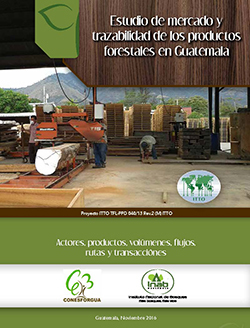New study on timber tracking in Guatemala
8 March 2017

The aim of the study, Estudio de mercado y trazabilidad de productos forestales in Guatemala, is to generate and disseminate information on the characteristics of Guatemala’s domestic timber market, including the flow of timber and timber products, timber species and volumes, timber transport routes, actors in the supply chain, timber tracking and law enforcement, thus increasing market transparency.
The study was based on information obtained from the Electronic Forest Enterprise Information System (Sistema Electrónico de Información de Empresas Forestales –SEINEF), an output of another ITTO project (TMT PD 004/11 Rev.2 (M)). The purpose of SEINEF, which became operational in early 2014, is to register, monitor and control the flow of forest products through companies that are legally established and registered with INAB.
The main findings of Estudio de mercado y trazabilidad de productos forestales in Guatemala are as follows:
- Guatemala Province is self-sufficient in terms of the supply of raw materials, and it is the main hub of exports of primary processed timber products, especially sawnwood.
- Timber products in Chimaltenango Province are normally sold in the domestic market, with minimal processing.
- The municipality of San Agustín Acasaguastlán accounts for the largest share of processed timber products yet has the least number of no-registered enterprises, making it an important area for further monitoring through timber tracking as well as incentives for further processing.
- The main timber species recorded in the three areas are Pinus species, Cupressus lusitanica, Tectona grandis, Hevea brasilensis, Swietenia macrophylla, Gmelina arborea and Chamaecyparis lawsoniana.
A complementary study produced under the ITTO project, Análisis de vulnerabilidad de comunidades vinculadas a las cadenas productivas forestales, analysed the positive and negative impacts of forest production chains on rural communities. The study concluded that the cost of legality for forest smallholders (harvesting less than 62 m3 of round timber per year) is high and uneconomically attractive, and tailored financial incentives and other measures to vertically integrate forest production are therefore required to reduce transaction costs and incentivize legality. The study recommended that intermediaries between the forest smallholders and the processing timber companies should be monitored with the aim of strengthening forest governance.
It is expected that these and other findings of the two studies will assist Guatemalan authorities in their efforts to improve forest governance in the country.
Project outputs can be obtained by inserting the project code (TFL-PPD040/13 Rev.2 (M)) in ITTO’s project search function.